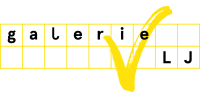Mu Pan’s show at Colección Solo in Spanish newspaper El País
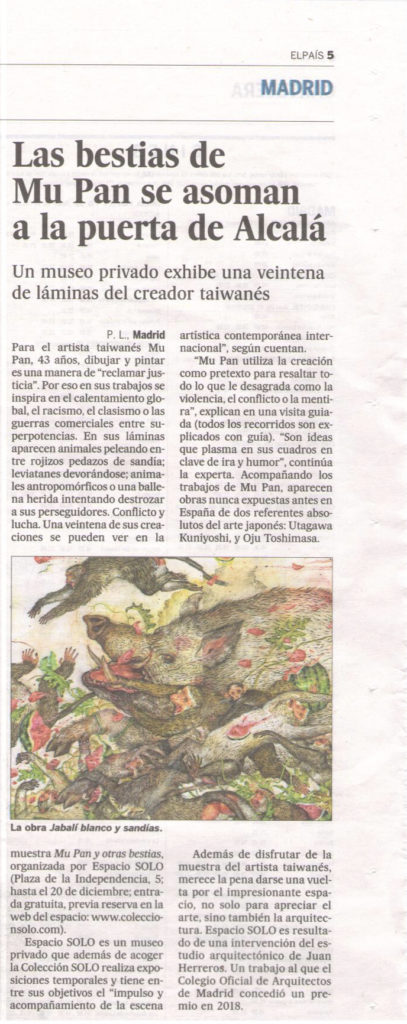

El universo surrealista de Mu Pan se expone en Madrid :
Sus pinturas son un homenajes al Bosco: utiliza colores rojos, ocres y negros en escenarios dantescos con criaturas fantásticas para denunciar la guerra y el racismo.
Hablamos del universo surrealista del taiwanés Mu Pan, cuya obra se expone en el Espacio Solo de Madrid.
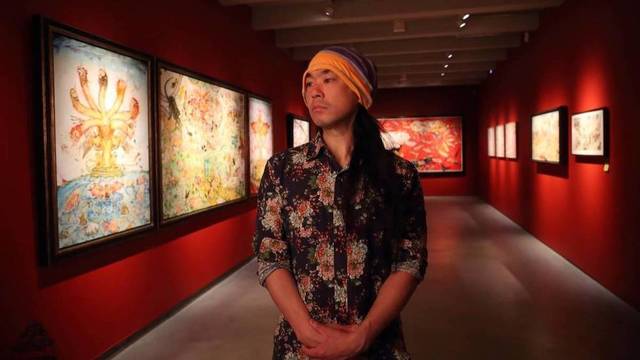
Imagen: Cortesía de Colección SOLO
Descubre el infinito universo de MU PAN, la primera exposición del Espacio SOLO en España.
https://vanidad.es/mixed-up/951406266/Esta-exposicion-es-la-exposicion-que-acaba-de-inaugurar-el-Espacio-SOLO-.html
Mu Pan es una presencia incómoda. Demasiado. Demasiado, incluso, en el más o menos vanguardista mundo del arte. Nihilista, socarrón y profundamente deslenguado, sus dardos alcanzan a los políticos (de todos los signos), el etnocentrismo cultural occidental y el establishment de su propio gremio, al que señala con el dedo sin miramientos. Normal que siga exponiendo en galerías independientes. Hablamos con él con motivo de la muestra que le dedica el madrileño Espacio Solo. Melifluos, abstenerse.
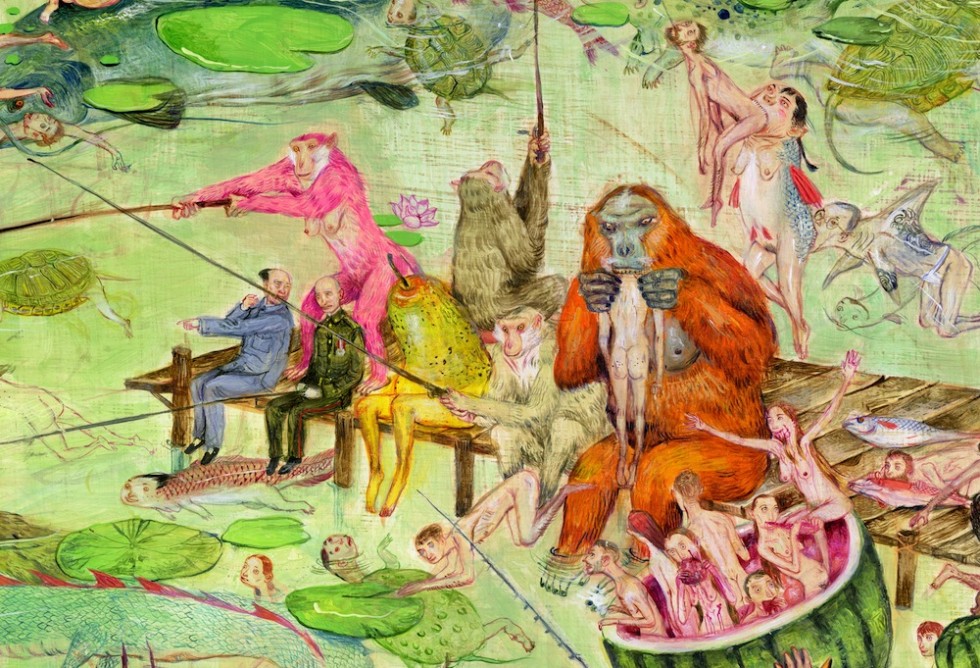
¿Cuándo decidiste que querías ser artista?
Nunca he querido serlo. Lo que siempre he querido, hasta donde alcanza mi recuerdo, es pintar. Soy extremadamente afortunado por poder ganarme la vida con esto.
Tu trabajo presenta grandes semejanzas con la figura de los yokai, los monstruos (muchas veces benévolos) que han formado parte de la tradición artística japonesa desde el siglo XIV. ¿Qué es lo que te atrae de ellos?
Me gustan no los yokai en sí, sino algunos concretos como Ukiyo-e, del periodo Edo, y los nishiki-e de la era Meiji, porque consisten únicamente en contornos y colores planos. Y también su contenido narrativo. No me considero especialmente influido por ellos, sino más bien por los monstruos ilustrados de la tradición china, recogidos en el Libro del Mar y la Montaña. Son formas muy crudas y simples, incluso cómicas, pero de manera incómoda. Gran parte de mi imaginario proviene de estas formas, que he reinterpretado en mi trabajo. Intento mantener en mis cuadros el espíritu burlón de las figuras originales.
Tradicionalmente, estas criaturas encarnan el temor a los espíritus, al potencial destructor de las fuerzas de la naturaleza y a los propios fantasmas de la mente. ¿Son también tus cuadros una representación de tus temores?
No. Para mí los yokai son criaturitas muy monas e interesantes, nunca me han parecido amenazadoras.
Muchas de tus figuras son antropomorfas, pero incorporan rasgos animales y fantásticos. ¿Crees que algunos rasgos del carácter humano se reflejan más fielmente con atributos de este tipo?
Creo a estas criaturas para burlarme del género humano. La gente intenta a menudo disociar la condición animal y la humana. Pero somos animales y actuamos igual que ellos.
Tu obra revela un profundo interés por la cultura pop, especialmente por el cine de ciencia ficción y el cómic: multitud de superhéroes de las clásicas editoriales Marvel y DC pululan por tus cuadros. ¿Qué es lo que te gusta de ellos?
La verdad es que odio a los superhéroes. No leo los cómics de estas editoriales ni veo las películas que se ruedan sobre ellos. Para mí son la cosa más tonta del mundo. He recurrido a ellos en el cuadro Loyal Retainer – Capítulo Final, que tiene una intención concreta, pues para mí la idea de los superhéroes es tremendamente racista. Es la propaganda y el lavado de cerebro característicos de los Estados Unidos. No comparto la idea de que el mundo esté llamado a ser salvado por hombres blancos, ingleses, guapos y de ojos azules. Y no entiendo que la gente de su propia industria no los considere ridículos. Ni siquiera permito a mi hijo que vea esa basura, porque lo que quieren es que todos los niños de otras razas vean a los hombres blancos americanos como los mejores del mundo y los naturalmente dominantes, de manera que más tarde acepten ser controlados por ellos.
Tienes tendencia a construir episodios épicos. ¿Por qué es el componente narrativo tan importante para ti?
Me encantan las películas épicas, incluso imparto clases sobre este tipo de ilustración. Es el único modo de crear imágenes que concibo. Y como ya he dicho, no soy un artista, el arte no me importa lo más mínimo. Lo único que hago es pintar y narrar historias con ello.
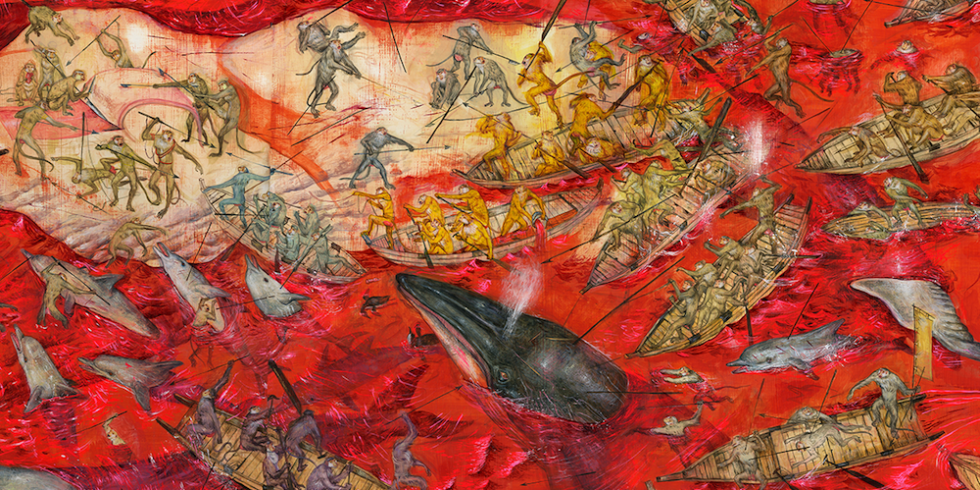
La mayoría de tus cuadros muestran escenas de guerra y seres que luchan contra la adversidad. ¿Es así como percibes a la humanidad? ¿Crees que vivimos en un mundo competitivo?
Creo que hay algo hermoso en la guerra. Es trágico que sea la forma más baja con la que los políticos aseguran sus puestos y sus beneficios económicos. Los soldados íntegros han dado lugar a personajes maravillosos, y también han escrito la historia. Hay que ser un gran artista para concebir una guerra. Los señores de la guerra tienen que dominar un sinfín de estrategias, como la formación de sus soldados, el contexto económico y geográfico, el número de luchadores de cada bando y el arte del lavado de cerebro en pos de la lealtad y el sentido de la misión. Dirigir todo esto requiere una enorme paciencia, carisma e inteligencia. Ya sea para invadir o para defender, para mí es bello cómo una persona puede reunir la fuerza individual para convertirse en un gran luchador contra su oponente. En este sentido, admiro la fuerza del hombre y de los animales. Sueño con alcanzar el poder para dirigir, destruir e infundir miedo a mis enemigos. Obviamente, esto es imposible, nadie tiene ese tipo de poder hoy en día. Así que he creado un mundo a mi medida con mis dibujos. Puedo ser quien quiera ser y comerme a cualquiera a quien no soporte. De hecho, cada monstruo que dibujo es un autoerretrato.
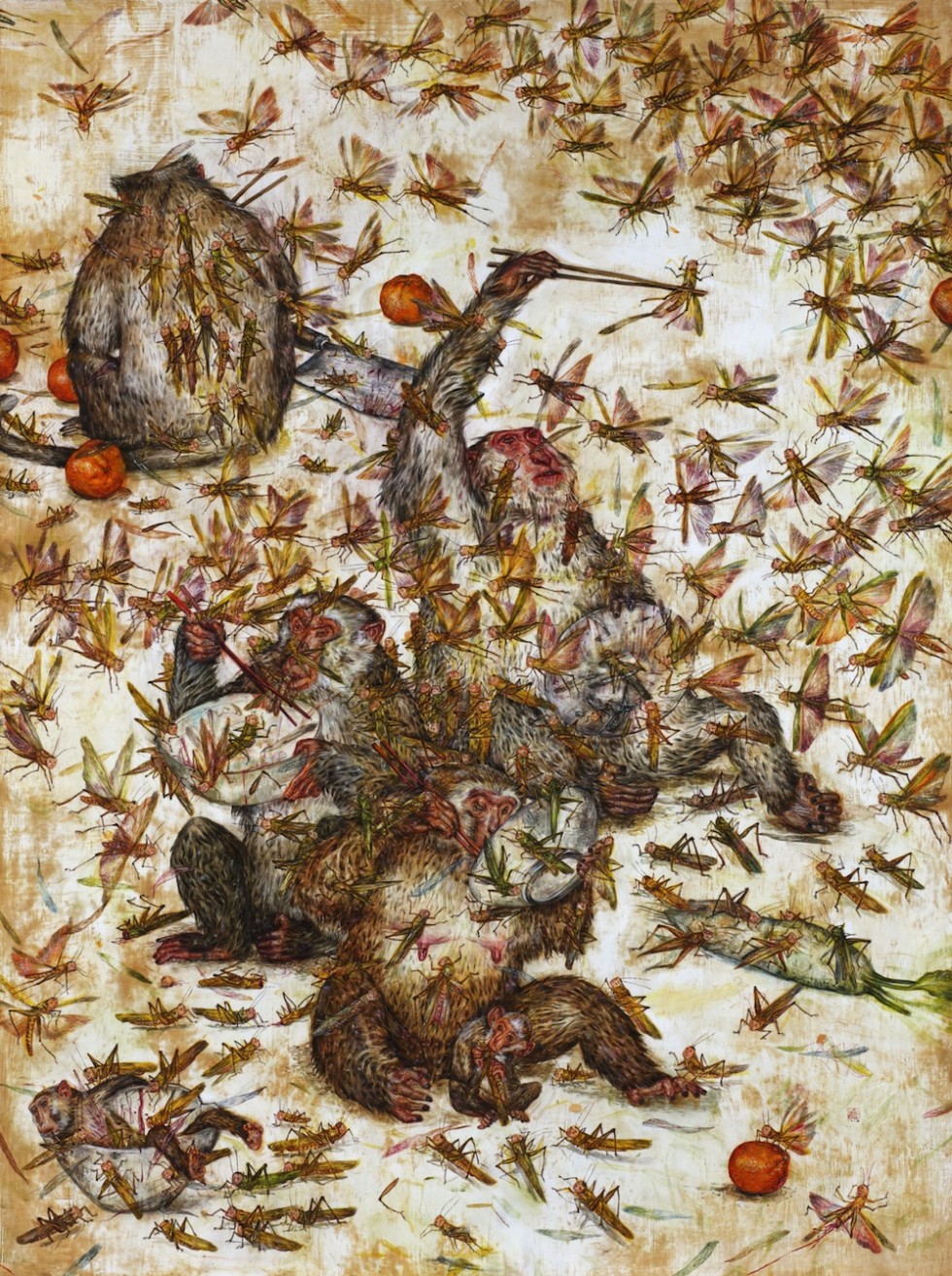
En tus cuadros, todas esas batallas involucran a masas, nunca son un cuerpo a cuerpo. ¿Crees que la violencia parte del individuo, de la sociedad o de ninguno de ellos?
Somos personas, somos monos parlantes. Tenemos un instinto animal, y eso hace que desafortunadamente, cuando las alternativas cívicas no funcionan, utilicemos la violencia como solución final. El odio es lo único que la humanidad practica y cultiva mejor que cualquier otra especie. Nos empuja a avanzar. El odio de un individuo es solo energía negativa, pero cuando un colectivo comparte el mismo odio, este se convierte en un poder magnífico que puede cambiar cualquier cosa, incluso los hechos, en favor del bando victorioso. Para el ser humano la violencia es la vía más eficiente. Y es triste, pero muchas veces lo es también para alcanzar la paz. En mi obra, la idea de violencia se presenta de forma bastante cómica, aunque haya sangre por todas partes. Me gusta exagerarla para darle una apariencia manga, incluso caricaturesca. Creo que el punto violento de mi obra es divertido, del mismo modo que puede serlo en South Park.
Tus ilustraciones también evidencian un elevado interés por la Historia y la política (por ejemplo, los indios, los vaqueros y los Estados Confederados de América durante la Guerra de Secesión). ¿Crees que el pasado determina el futuro?
Por supuesto. La gente nunca aprenderá. Aquí en Estados Unidos ves cómo la historia se repite cometiendo los mismos errores una vez cada cuatro años.
El propio Donald Trump y Hillary Clinton aparecen en tu obra “Two Pieces of Shit You Pick One That Stinks Less To Ya” (“Dos trozos de mierda, elige el que te parezca menos apestoso”). Se trata de una postura muy explícita, ¿es importante para ti mostrar un cierto compromiso político?
No creo en la democracia. No voto, nunca lo he hecho. No tomo partido, detesto a todas las facciones por igual.
Elegiste la pintura de entre todas las disciplinas artísticas que existen. ¿Por qué?
El dibujo, no la pintura. Esta última no me gusta, es algo propio de Occidente. Aunque algunas de mis obras incorporan color, siguen siendo dibujos. Me gusta el trabajo lineal, que es el más primitivo. Así lo hacíamos antes de tener constancia de las diferentes razas y culturas.

Tu trabajo refleja tu propio mestizaje cultural, como un nativo taiwanés que inmigró en Estados Unidos a los 21 años, a mediados de los 90. ¿Cómo recuerdas ese contraste cultural y cuál ha sido tu experiencia en este país desde entonces?
Desde mi punto de vista, no existen los nativos tawianeses. Solo los indígenes de Taiwán son realmente nativos. La denominación de taiwaneses, o nativos taiwaneses, es un invento de la prensa occidental para dividir a la población china. De hecho, si la comunidad internacional ama tanto Taiwán, ¿por qué en los años 50 reconocieron la República Popular China en lugar de la República de China (Taiwán)? Yo soy chino y siempre lo seré, aunque no sea ciudadano de China. Igual que lo fueron todos mis antepasados en los últimos 4.000 años. Nunca seré americano, ni siquiera asiático-americano. He aprendido su cultura porque vivo aquí, pero nunca me permitiré formar parte de ella. En lo más profundo, en mi forma de pensar y mis valores morales, sigo siendo chino. Cuanto más tiempo vivo aquí, más ridiculeces me encuentro. Pero no pienso irme. Voy a verlo todo desde aquí, sea bueno o malo.
¿Crees que el arte y la política tienen una relación natural? ¿Dirías que los artistas suelen tener una cierta tendencia contestataria?
Depende de la elocuencia que tengan esos supuestos artistas. No hay más que mirar a esos artistas de primera fila, que se dan a sí mismos ese nombre y proclaman peroratas sobre la vida, la creación y todo lo demás, pero tienen múltiples propiedades y una fábrica como estudio, con un montón de asistentes para crear su “arte”. La forma en que lo llevan no persigue más que el poder y la notoriedad, igual que lo hacen los caudillos o los líderes de una secta.
¿Qué asuntos sociales y políticos te preocupan tanto como para reflejarlos en tus obras?
El medio ambiente. No nos merecemos vivir en este planeta, no hacemos más que destruirlo. Así lo hice constar en mi ilustración de la gran ballena, que simboliza muchas de las amenazas medioambientales a las que nos enfrentamos hoy.
¿A qué artistas admiras?
A Henry Darger.
¿Qué opinas de la escena artística actual?
El arte es como el traje nuevo del emperador, y yo soy demasiado estúpido para verlo.
¿Cómo te gustaría ser recordado?
¿Cómo le gustaría a un granjero o un fontanero ser recordado?
Texto: Carmen Cocina Imágenes: Cortesía de Colección SOLO
Galerie LJ is thrilled to announce the opening of the first retrospective show of Chinese-American artist Mu Pan, at Colección SOLO, a private museum and amazing collection in Madrid, until July 26, 2019.
Mu Wen Pan was born in Taichung City, Taiwan, in 1976, and initially opted for art school as a means of escaping a career in the military. He moved to the USA in 1997 with his family and studied at the School of Visual Arts in New York where he earned an MFA with honors in 2007. A firm believer in humanitys basic need for narrative in visual imagery, Mu Pan describes his work as “quite simply about telling stories.” In his intricate battle scenes, human figures, beasts and bizarre mixtures of the two come together in epic life-and-death struggles.

With influences ranging from Hong Kong cinema of the 1980s and 1990s to Japanese manga and kaiju movies, he incorporates elements of Chinese history and mythology to tell epic stories and legends with modern sensibilities. Mu Pans artwork is never about art for its own sake – in his own words, “I am just an otaku who draws.”
As an artist who tells stories of epic, large-scale battles, war is one of Mu Pans primary inspirations. He often draws from the theatre of modern events to find inspiration for his work. “Usually, when Im excited about something I saw or read on the media, or from my daily life, I first associate the subject with a monster or some creatures on a large scale, then think about who it will be fighting with.”
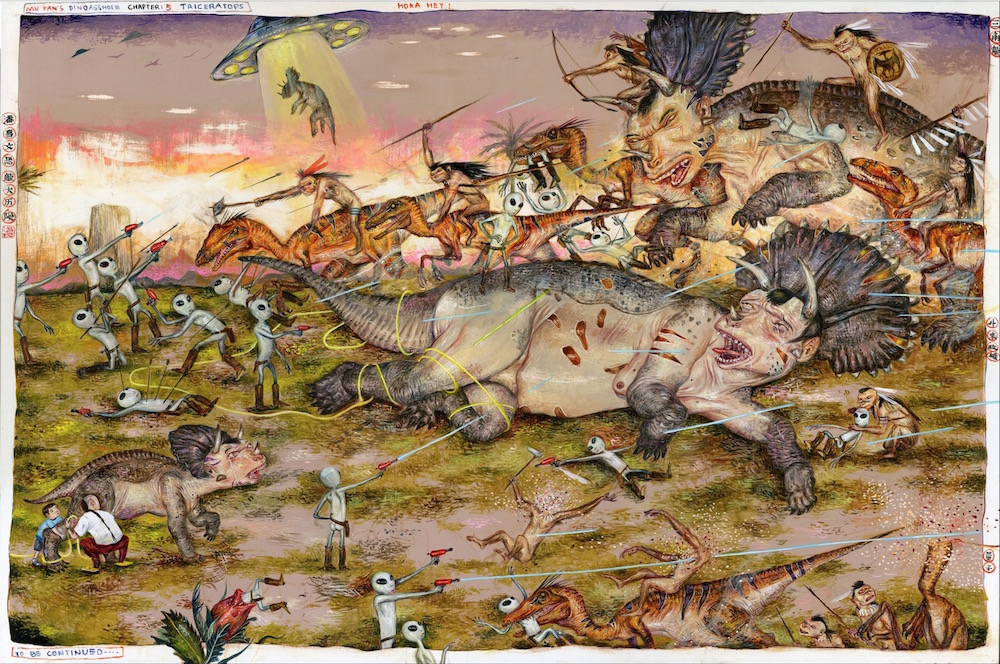
This outstanding exhibition brings together 20 paintings and drawings by the artist from 2014 to 2019, a trailer of the documentary currently in progress by the collection, as well as documented sources and references used by Mu Pan, including plates by ukiyo-e master, Utagawa Kuniyoshi.
Mu Wen Pan was born in Taichung City, Taiwan, in 1976, and initially opted for art school as a means of escaping a career in the military. He moved to the USA in 1997 with his family and studied at the School of Visual Arts in New York where he earned an MFA with honors in 2007. A firm believer in humanitys basic need for narrative in visual imagery, Mu Pan describes his work as “quite simply about telling stories.” In his intricate battle scenes, human figures, beasts and bizarre mixtures of the two come together in epic life-and-death struggles.
[FR] Nous sommes très fiers d’annoncer que la prestigieuse Colección SOLO présentera la 1ère exposition rétrospective de oeuvres de Mu Pan qu’elle possède, et plus encore, à partir du 26 avril. .
“Mu Pan Y Otras Bestias”, du 26 avril au 26 juillet 2019.
Une monographie sera publiée ultérieurement à cette occasion.
[ENG] We are very proud to announce that the prestigious Colección SOLO in Madrid will present the first retrospective exhibition of Mu Pan, from April 26th.
“Mu Pan, And Other Beasts”, 26 April to 26 July 2019.
+ infos : https://coleccionsolo.com/visits/

Swoon Has Completely Transformed a Museum With Her Captivating Paper Cut-Outs
Show of the Day: “The Canyon” at the Cincinnati Contemporary Arts Center.
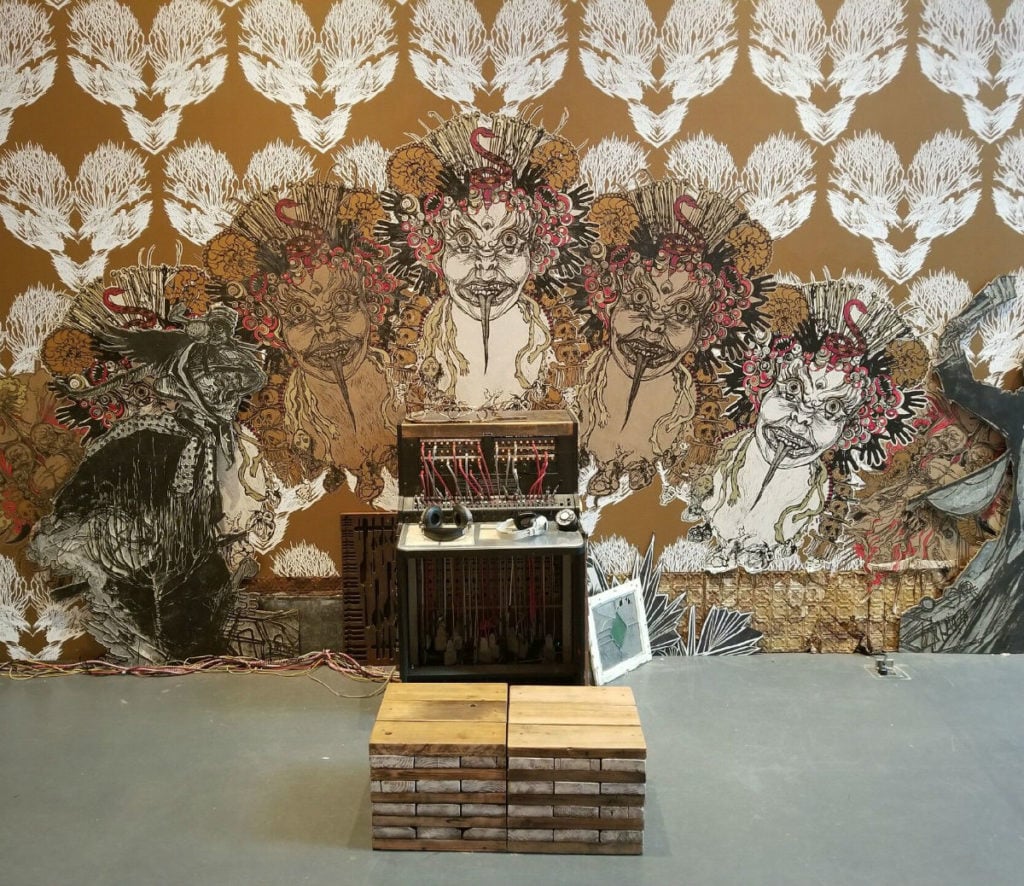
SWOON
“The Canyon”
Contemporary Arts Center, Cincinnati
What the Museum Says: “Swoon [aka Caledonia Curry] is a pioneering social champion in a field traditionally dominated by men, machismo and activities deemed illegal; she has overcome every barrier to re-define what ‘street art’ means today. This exhibition showcases multiple dimensions of Curry’s multi-faceted practice, including a new site-specific installation, re-stagings of past landmark projects and a survey of her socially-driven work in countries like Haiti and Kenya.”
Why It’s Worth a Look: Completely consuming the space of the Zaha Hadid-designed Contemporary Arts Center in Cincinnati, “The Canyon” recalls the celebrated street artist’s beginnings as a guerrilla artist New York. It features, among other works, a new immersive, mixed-media installation, “Medea,” reflecting on Swoon‘s childhood, during which she witnessed her parent’s lifelong struggle with addiction and substance abuse. The relevance of the many subjects Swoon has addressed in her cut-paper wall works throughout her 18-year career, ranging from the opioid crisis, to the treatment of refugees, to women’s issues, gives this show a significance that is even greater than the sum of its impressive parts.
What It Looks Like:
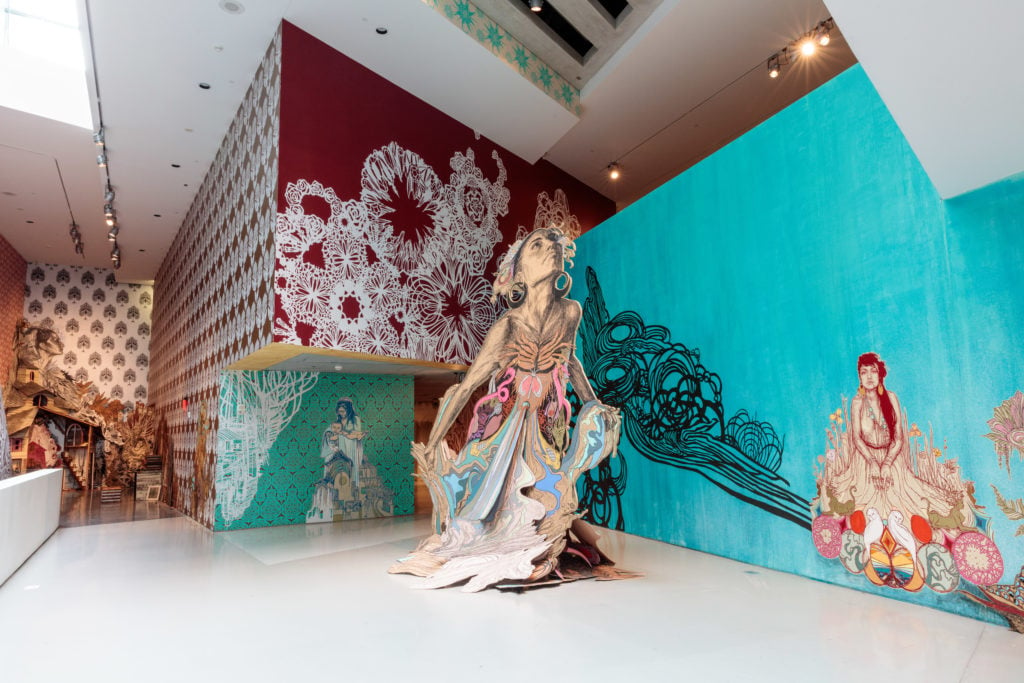
Swoon’s Thalassa in “The Canyon” at Contemporary Arts Center, Cincinnati. Photo courtesy Tod Seelie.
One of the most influential and progressive street artists to lead the genre, Brooklyn-based Swoon opens a massive career retrospective in Cincinnati at the Contemporary Arts Center.
Long one of the originators and pillars of the international movement that became Street Art as we know it today, Swoon has been an artist that can think big in terms of massive installations and performance pieces, as well as spiritually with philanthropic projects and poetic street wheatpastes. Having known her for years, I always find it a bit misleading to call her just a streer artist, but that spirit and DIY mentality, that owning a universe and transforming a space into an immersive world is something Swoon does better than most artists. From her trek down the Mississippi River in the Miss Rockaway Armada, or her stunning installations in the Brooklyn Museun and DIA in Detroit are just a few examples of how she has created an aesthetic and work ethic that is all about that spacial transformation and putting the viewer into the actual work itself.
The CAC, in presenting The Canyon: 1999—2017, the first major survey of Swoon’s work to date, says of the artist: “pioneering social champion in a field traditionally dominated by men, machismo and activities deemed illegal; she has overcome every barrier to re-define what ‘street art’ means today.” And that is such an important fact, this idea that in a genre initially dominated by men, Swoon was and is one of the great historical figures of that early era of Street Art that is also occupied by the likes of Banksy, Shepard Fairey, or Faile. She is a pillar. For The Canyon, the iconography is familar, the installations complex yet fragile in a way we have come to know her best work. That is why this is a proper retrospective in that it has all the hallmarks of Swoon’s career, yet so visually unique and refreshing to see in mass. With new site-specific works in the exhibition, this is the beginning of a new chapter for the artist, all the while we can celebrate just how one-of -a-kind Swoon is to the contemporary art community. —Evan Pricco
All images via CAC
The Contemporary Arts Center of Cincinnati announces Swoon’s early career retrospective for this September :
The CAC is organizing the first major survey of era-defining artist Caledonia Curry – better known as Swoon. Swoon is a pioneering social champion in a field traditionally dominated by men, machismo and activities deemed illegal; she has overcome every barrier to re-define what “street art” means today. This exhibition showcases multiple dimensions of Curry’s multi-faceted practice, including a new site-specific installation, re-stagings of past landmark projects and a survey of her socially-driven work in countries like Haiti and Kenya.
By humble means of drawing, printmaking, wheatpaste and cut paper, Curry has given life to a burgeoning family of faces and figures who take on extraordinary presence when placed in public space. To bring people closer, she explains, “I make [the figures] human-scale and close to the ground, so you have a one-on-one experience. I call them vessels of empathy. ” Curry congregates equally colorful communities of real life characters when collectively building music houses in New Orleans, earthbag community centers in Haiti, and rafts out of NYC garbage that become surreal vessels floating down the Grand Canal in Venice.
To expand the impact of Swoon’s time in Cincinnati, the CAC initiated her participation in the Cincinnati Ballet’s 2017 New Works performance which will take place April 20-30. In collaboration with renowned choreographer Jennifer Archibald, Curry will design a newly created stage set that will subsequently become part of the CAC exhibition.
One of the foremost practitioners of modern street art — a female artist known as “Swoon” — has two upcoming projects in Cincinnati.
 The artist “Swoon” with her set for Cincinnati Ballet’s New WorksPHOTO: HAILEY BOLLINGER
The artist “Swoon” with her set for Cincinnati Ballet’s New WorksPHOTO: HAILEY BOLLINGER
As street art becomes so accepted and popular a genre that its most outstanding practitioners have developed international followings, one of the foremost — a female artist known as “Swoon” — has two upcoming projects in Cincinnati.
The first is a collaboration with choreographer Jennifer Archibald for the Cincinnati Ballet’s The Kaplan New Works Series, which opens Thursday at the Aronoff Center’s Jarson-Kaplan Theater and continues through April 30. All four of the pieces in the program are by women choreographers.
The second project is a major art event — the Contemporary Arts Center says it will open a museum survey of her career to start the upcoming exhibition season. Called SWOON: 2002-2017, it opens Sept. 22 and will be up through Feb. 25, 2018.
Born Caledonia Curry, Swoon began wheatpasting life-size woodblock-printed and hand-painted portraits of friends and family onto walls in New York City in 1999, when she was just a college student studying art at Pratt Institute. Her work quickly gained the attention of pedestrians and gallerists alike.
“First and foremost I am a drawer of portraits,” she says.
Using humble materials, temporary approaches and by “getting up” enough work on the street, by the mid-2000s Swoon was becoming familiar enough that she had already sold pieces to New York’s Museum of Modern Art and had a solo show at Deitch Projects gallery — all this merely a few years out of college.
In addition to more traditional gallery shows, Swoon has also initiated long-term site-specific artistic endeavors in places like Haiti, New Orleans and Braddock, Pa., which use art as a way to galvanize communities.
Like Swoon, choreographer Archibald has worked widely. She’s the founder and artistic director of New York City’s Arch Dance Company, and she’s just been named resident choreographer for Cincinnati Ballet’s upcoming season.
Archibald says via email that she and Swoon met in New York last summer. They’ve been collaborating virtually ever since, sending each other photos and videos and tossing ideas and materials back and forth.
For Archibald’s New Works piece, entitled “Never.Nest,” Swoon repurposed elements from a raft that she floated on the Adriatic Sea. The seaworthy craft was made from discarded furniture and architectural objects that the artist and her crew had gathered from abandoned warehouses and garbage piles along the coast around Slovenia.
The conceptual framework of the collaborative dance piece draws on that. “(It’s about) climate change and coastal cities and our relationship to nature in this moment,” Swoon says. “And (also) our need to viscerally process what’s happening.”
The technical challenges for this particular project are specific to the theater. Grappling with issues of scale, time and mobility requires work.
“It can be fun creative problem-solving,” Swoon says. “Or maddening. Or both.”
“Usually both,” she adds, with a laugh.
The first time Swoon came to Cincinnati was in 2004 for the trendsetting Beautiful Losers: Contemporary Art and Street Culture exhibition at the CAC. Her work was actually exhibited at now-shuttered Publico gallery, one of several satellite locations around the city that hosted the various participating street artists.
It should come as no surprise then that the CAC was interested in bringing Swoon back for a solo show of her work. There is already a committed base of supporters for this kind of art, and what Swoon does with her intricate portraits and installation work is different than other street artists.
The survey of her works that opens in September at the CAC will offer her at chance to reflect on her career. She also has plans to go “off-radar” for at least a year after the survey show. Then, when it comes time to tackle an installation again, Swoon says she will be looking for the next big challenge.
“I kind of know what I’m doing and that’s just not good for an artist,” she says, “or else you’re not living a truly creative life.”
Email hello@galerielj.com
Tel +33 (0) 1 72 38 44 47
Adresse
32 bd du Général Jean Simon
75013 Paris, France
M(14) BNF
RER (C) BNF
T(3a) Avenue de France
Horaires d'ouverture
Du mardi au samedi
De 11h à 18h30
